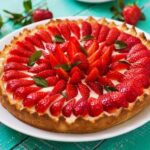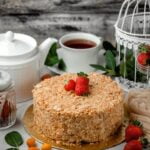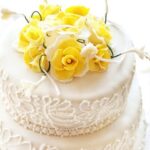Are you looking to learn how to decorate a cake at home for beginners? The art of cake decorating is a wonderful skill that allows you to express your creativity and make delicious treats even more beautiful. Whether you’re planning to bake for a special occasion or just want to add some pizzazz to your homemade desserts, mastering the basics of cake decorating is a fantastic place to start.
In this article, we will guide you through the process of learning how to decorate a cake at home for beginners. From gathering essential tools and ingredients to understanding basic techniques and creative decoration ideas, we have everything you need to get started on your cake decorating journey. We’ll also provide helpful tips and tricks for improving your skills, so you can continue honing your craft over time.
So, if you’re ready to elevate your baking game and impress your friends and family with beautifully decorated cakes, read on for our comprehensive beginner’s guide to cake decorating. With a little practice and patience, you’ll be well on your way to creating stunning desserts that not only taste amazing but look absolutely gorgeous as well. Let’s get started.
Setting the Stage
When it comes to decorating a cake at home, having the right tools and ingredients is essential for success. Here are some key items you’ll need to gather before you get started.
Essential Tools
First and foremost, you’ll need basic baking equipment such as mixing bowls, measuring cups and spoons, a whisk or electric mixer, and cake pans. In addition to these, investing in cake decorating specific tools like offset spatulas, piping bags and tips, and a turntable can make the decorating process much easier.
Key Ingredients
Of course, you’ll also need the necessary ingredients to bake your cake. This includes flour, sugar, baking powder/soda, salt, eggs, butter or oil, and flavorings like vanilla extract. Depending on the type of decorations you plan to use, you may also want to have ingredients for making frosting such as powdered sugar, butter or shortening, and milk or cream.
Specialty Items
If you’re looking to take your decorating skills up a notch from the very beginning, consider investing in some specialty items such as edible food coloring gels/pastes for vibrant colors and fondant for creating intricate designs. These items can add a professional touch to your beginner cakes while still being manageable for someone new to decorating.
By ensuring that you have all the necessary tools and ingredients at hand before starting your cake decorating journey, you set yourself up for success in creating beautiful and delicious treats right from your own kitchen.
The Foundation
Baking and preparing the cake is a critical step in the cake decorating process. To create a beautiful canvas for your decorations, it’s essential to start with a well-baked and properly prepared cake. Here are the key steps to mastering this foundational aspect of cake decorating:
- Choose the Right Recipe: Begin by selecting a recipe that suits your skill level and desired flavor. Whether it’s a classic vanilla sponge or a rich chocolate cake, make sure to follow the instructions carefully.
- Prepare Your Pan: Properly grease and flour your cake pan to ensure easy release once the cake is baked. You can also line the bottom of the pan with parchment paper for added insurance.
- Baking Techniques: Pay attention to baking times and temperatures specified in the recipe. Use an oven thermometer to ensure accurate temperature and avoid over or under-baking your cake.
- Cooling and Leveling: Once your cake is baked, allow it to cool completely in the pan before transferring it to a wire rack. After cooling, use a serrated knife or cake leveler to trim off any domed top and create an even surface for decorating.
By mastering these foundational steps, you’ll be setting yourself up for success in creating a beautifully decorated cake. With a well-baked and leveled cake as your starting point, you’ll have a solid foundation on which to practice the art of decoration.
Next, we’ll dive into basic techniques for decorating your cake, offering guidance on how to add simple but elegant designs using readily available tools and ingredients.
Getting Started
When it comes to learning how to decorate a cake at home for beginners, it’s important to start with the basics. Understanding fundamental techniques will set the stage for creating beautifully decorated cakes. Here are some essential basic techniques to get you started on your cake decorating journey.
Crumb Coating
Before you begin decorating your cake, it’s important to create a smooth and even surface by applying a crumb coat. This thin layer of frosting seals in any loose crumbs, making it easier to apply the final layer of frosting without any unsightly crumbs getting in the way.
To crumb coat a cake, simply spread a thin layer of frosting over the entire cake and then chill it in the refrigerator for about 30 minutes before adding the final layer of frosting.
Flat Icing Technique
Once your cake has been crumb coated, you can start applying the final layer of frosting using the flat icing technique. This involves spreading a thick layer of frosting over the entire cake using an offset spatula or icing smoother. Start by applying a generous amount of frosting on top of the cake and then work your way down the sides, smoothing as you go until you have an even layer of frosting covering the entire cake.
Simple Piping Techniques
Piping is a versatile and essential skill for any beginner cake decorator. By mastering simple piping techniques, you can create beautiful designs and decorations on your cakes. Practice piping borders, dots, stars, rosettes, and other basic shapes on a practice board or parchment paper before trying them on your cake. With time and practice, you’ll become more confident with piping and be able to create intricate designs on your cakes.
By mastering these basic techniques for decorating cakes, beginners can gain confidence and skill in creating beautifully decorated sweet treats at home. Whether you’re preparing a birthday cake or simply want to indulge in some creative baking, these foundational skills are essential for any aspiring home baker looking to improve their decorating abilities.
Let’s Get Creative
When it comes to decorating a cake at home for beginners, there are plenty of simple and easy decoration ideas that can make your cake look impressive without requiring advanced skills. One popular option is using fresh fruits as a topping for your cake.
Sliced strawberries, blueberries, or raspberries can add a pop of color and a touch of freshness to your creation. Another idea is to use edible flowers like pansies or roses to add an elegant and natural touch to your cake.
If you want to get more artistic with your cake decorations, consider using chocolate ganache or candy melts to create an eye-catching drip effect on the sides of your cake. Simply pour the melted chocolate or candy over the top edge of your cake and let it naturally run down the sides for a professional-looking finish.
You can also try playing with different textures and patterns by using stencils and powdered sugar or cocoa powder to decorate the top of your cake. Place a stencil on the surface of your cake, sift powdered sugar or cocoa over it, then carefully lift off the stencil to reveal a beautiful design. This technique is especially forgiving for beginners and allows for endless creativity without requiring intricate piping skills.
| Cake Decoration Idea | Description |
|---|---|
| Fresh fruit toppings | Simple yet colorful and fresh addition to any cake |
| Chocolate ganache drip | Adds a professional touch with minimal effort |
| Stencil and powdered sugar design | Allows for creativity without intricate piping skills |
Step by Step
Using a piping bag and tips is an essential skill for beginner cake decorators. With the right tools and techniques, you can create beautiful and intricate designs on your cakes. Here’s a step-by-step guide on how to use piping bags and tips to elevate your cake decorating skills.
Step 1: Assemble Your Supplies
Start by gathering all the necessary supplies, including a piping bag, coupler, and various decorating tips. Make sure to choose the right tip for the design you want to create, whether it’s rosettes, leaves, or intricate borders.
Step 2: Prepare the Piping Bag
Insert the chosen decorating tip into the coupler and then attach it to the end of the piping bag. Once secure, trim the end of the piping bag to fit the size of the tip. Pro tip: Place the piping bag in a tall glass and fold down the edges for easy filling.
Step 3: Fill With Frosting
Scoop your desired frosting into the piping bag, making sure not to overfill it. Twist or fold down the top of the bag to prevent any frosting from spilling out while you’re decorating.
Mastering how to use piping bags and tips may take some practice, but with patience and dedication, you’ll soon be creating professional-looking designs on your homemade cakes. Remember that practice makes perfect when it comes to cake decorating, so don’t be afraid to experiment with different tips and techniques. Before you know it, you’ll be impressing your friends and family with your beautifully decorated cakes.
Adding Flair
One of the most enjoyable parts of cake decorating is adding edible decorations and garnishes to your creation. These elements not only add visual appeal to your cake but also provide an extra layer of flavor and texture for the ultimate culinary experience. While this step may seem daunting for beginners, it can actually be quite simple and fun with the right guidance.
When it comes to incorporating edible decorations and garnishes, it’s important to consider both taste and aesthetics. Fresh fruits such as berries, citrus slices, or even edible flowers can add a burst of color and natural sweetness to your cake.
Nuts, chocolate shavings, or sprinkles are great options for adding a delightful crunch or a touch of indulgence. You can also explore using flavored syrups or fruit coulis to add a splash of vibrant color and enhance the overall taste of your creation.
To incorporate these edible decorations effectively, consider the overall theme or flavor profile of your cake. For example, if you’re making a lemon cake, adding lemon slices as garnish can tie in the flavors beautifully. Similarly, if you’re decorating a chocolate cake, chocolate curls or cocoa powder dusting can complement the richness of the dessert. The key is to balance flavors and textures while creating an aesthetically pleasing presentation that invites people to indulge.
As a beginner learning how to decorate a cake at home, experimenting with different edible decorations and garnishes is an exciting way to unleash your creativity while elevating the visual and sensory appeal of your baked masterpiece. With practice and exploration, you’ll discover new combinations that will make your cakes stand out and captivate anyone who sees (and tastes) them.
Finishing Touches
After learning the basic techniques for decorating a cake at home, it’s time to add the final decorative touches that will make your cake shine. Whether you’re decorating a birthday cake, a special occasion cake, or simply want to practice and improve your skills, the finishing touches can truly elevate your creation. In this section, we will explore some simple yet effective ways to make your cake stand out with those final decorative touches.
One of the easiest ways to add a professional touch to your cake is by using edible decorations and garnishes. Sprinkles, edible glitter, colored sugar crystals, and even fresh fruit can all be used to add color and texture to your cake.
Consider matching the garnishes to the theme or flavor of the cake for a cohesive and visually appealing result. For example, fresh berries make a beautiful addition to a summer-themed cake, while gold or silver sprinkles can add an elegant touch to a celebratory cake.
In addition to edible decorations, consider adding a border or trim around the edges of your cake for a polished look. This can be achieved with piped frosting using a round tip, creating delicate swirls or beads along the top and bottom edges of the cake.
Alternatively, you could use chocolate ganache for a drip effect around the sides of the cake, or create intricate patterns using royal icing. These final decorative touches not only enhance the visual appeal of your cake but also show off your newfound decorating skills in an impressive way.
By mastering these finishing touches, you’ll soon be on your way to creating beautifully decorated cakes at home. With practice and experimentation, you’ll find new ways to elevate your cakes with decorative accents that are sure to impress family and friends.
Whether it’s through using edible garnishes, adding borders and trims, or incorporating unique design elements, each finishing touch brings you one step closer to becoming an expert in how-to decorate a cake at home for beginners.
Practice Makes Perfect
So, you’ve baked and decorated your first cake at home as a beginner, and now you’re ready to take your skills to the next level. The good news is that practice really does make perfect when it comes to cake decorating. Here are some tips for improving your decorating skills and becoming even more confident in creating beautiful and delicious treats.
First, don’t be afraid to experiment with different techniques and designs. Try out new piping tips, practice making different shapes and designs with frosting, and don’t be discouraged if things don’t turn out perfectly the first time. With each attempt, you’ll gain more experience and develop a better understanding of how to decorate a cake at home for beginners.
Another valuable tip for improving your cake decorating skills is to seek inspiration from professional bakers and skilled decorators. Watch tutorial videos, read books and articles on cake decorating, and pay attention to the details of beautifully decorated cakes. By studying the work of experienced decorators, you can learn new techniques and gain insight into how to achieve professional-looking results.
Lastly, don’t underestimate the importance of patience and perseverance. Decorating cakes takes time and practice, so be patient with yourself as you continue to hone your skills. Remember that every mistake is an opportunity to learn and improve. By staying determined and regularly practicing your decorating techniques, you’ll soon see significant progress in your abilities.
Conclusion
In conclusion, learning how to decorate a cake at home for beginners can be a fun and rewarding journey. By setting the stage with essential tools and ingredients, mastering basic techniques, and getting creative with simple decoration ideas, anyone can create a beautifully decorated cake right in their own kitchen.
As you continue to practice and improve your skills, don’t be afraid to experiment with different piping techniques, edible decorations, and garnishes to add flair to your creations. Remember that practice makes perfect, so keep at it and don’t be discouraged by any mistakes along the way.
Ultimately, the joy of seeing your friends and family’s faces light up when they see your beautifully decorated cake will be more than enough reward for all your hard work. So embrace the journey, have fun, and enjoy celebrating your beginner cake decorating achievements. With dedication and creativity anyone can learn how to decorate a cake at home for beginners.
Frequently Asked Questions
What Does a Beginner Need for Cake Decorating?
A beginner in cake decorating will need basic tools such as a turntable, offset spatula, piping bags and tips, and a bench scraper. It’s also important to have a good quality frosting and food coloring.
How Do You Decorate a Cake in a Simple Way?
Decorating a cake in a simple way can be achieved by using fresh fruits, edible flowers, or even simple designs made with powdered sugar or cocoa powder. Adding a personalized message with piped frosting can also make the cake look impressive yet effortless.
What Can I Use to Decorate a Cake at Home?
To decorate a cake at home, you can use various ingredients such as chocolate shavings, sprinkles, edible glitter, or even small candies. In addition to these, you can create beautiful designs using whipped cream or buttercream frosting with different nozzles.

Welcome to my blog about home and family. This blog is a place where I will share my thoughts, ideas, and experiences related to these important topics. I am a stay-at-home mom with two young children. I hope you enjoy reading it! and may find some helpful tips and ideas that will make your home and family life even better!





